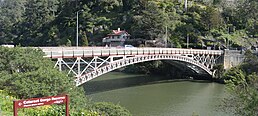
Back لاونسستون Arabic لاونسستون ARZ Lonseston Azerbaijani لانسستون، تاسمانی AZB Launceston (Tasmània) Catalan Launceston (lungsod) CEB لانسێستن، تاسمانیا CKB Launceston Czech Launceston, Tasmania Welsh Launceston (Tasmanien) German
| Launceston Tasmania | |||||||||||||||
|---|---|---|---|---|---|---|---|---|---|---|---|---|---|---|---|
 Flag | |||||||||||||||
| Coordinates | 41°26′31″S 147°8′42″E / 41.44194°S 147.14500°E | ||||||||||||||
| Population | 90,953 (2021) (21st) | ||||||||||||||
| • Density | 208.895/km2 (541.04/sq mi) | ||||||||||||||
| Established | 1806 | ||||||||||||||
| Postcode(s) | 7250 | ||||||||||||||
| Elevation | 15 m (49 ft) | ||||||||||||||
| Area | 435.4 km2 (168.1 sq mi)[1] (2011 urban) | ||||||||||||||
| Time zone | AEST (UTC+10) | ||||||||||||||
| • Summer (DST) | AEDT (UTC+11) | ||||||||||||||
| Location |
| ||||||||||||||
| LGA(s) | City of Launceston | ||||||||||||||
| Region | North-east | ||||||||||||||
| County | Cornwall | ||||||||||||||
| State electorate(s) | |||||||||||||||
| Federal division(s) | |||||||||||||||
| |||||||||||||||
| |||||||||||||||
Launceston (/ˈlɒnsɛstən/ [2][3][4]) is a city in the north of Tasmania, Australia, at the confluence of the North Esk and South Esk rivers where they become the Tamar River (kanamaluka). As of 2021, the Launceston urban area has a population of 90,953.[5] Launceston is the second most populous city in Tasmania after the state capital, Hobart.[6] Launceston is the fifth-largest inland city and the ninth-largest non-capital city in Australia. Launceston is regarded as the most livable regional city,[7] and was one of the most popular regional cities to move to in Australia from 2020 to 2021.[8] Launceston was named Australian Town of the Year in 2022.[9]
Settled by Europeans in March 1806, Launceston is one of Australia's oldest cities and it has many historic buildings.[10] Like many places in Australia, it was named after a town in the United Kingdom – in this case, Launceston, Cornwall. Launceston also had the first use of anaesthetic in the Southern Hemisphere, it was the first Australian city to have underground sewers, and it was the first Australian city to be lit by hydroelectricity.[11] The city has a maritime climate with four distinct seasons and is appreciably warmer than the south of the island during summer. Local government is split between the City of Launceston, Meander Valley and West Tamar Councils.
- ^ "2011 Census Community Profiles: Launceston". ABS Census. Australian Bureau of Statistics. Retrieved 15 September 2016.
- ^ Macquarie Dictionary, Fourth Edition (2005). Melbourne, The Macquarie Library Pty Ltd. ISBN 1-876429-14-3
- ^ "Launceston one of the hardest place names to pronounce in the country". Pulse Tasmania. 19 September 2023. Retrieved 28 July 2024.
- ^ Horn, Emma (21 September 2023). "Australia's hardest to say city name, according to Google searches". The Examiner. Retrieved 28 July 2024.
- ^ "Launceston - 2021 Census All persons QuickStats". ABS Census. Australian Bureau of Statistics. 28 June 2022. Retrieved 23 July 2023.
 Material was copied from this source, which is available under a Creative Commons Attribution 4.0 International License
Material was copied from this source, which is available under a Creative Commons Attribution 4.0 International License
- ^ Atkins, Ben M.; Vince, Joanna Z. (2009). "The Launceston flood policies: Levees and beyond". The Australian Journal of Emergency Management. 24 (3): 32–37. ISSN 1324-1540. Retrieved 2 November 2014.
- ^ Bailey, Sue (12 April 2018). "Launceston leads the way". The Examiner. Retrieved 8 July 2021.
- ^ Needham, Jack (5 July 2021). "The most popular spots for sea and tree-changers escaping the city". Illawarra Mercury. Retrieved 8 July 2021.
- ^ Brown, Vanessa (22 February 2022). "Surprise winner of Australia's best town". news.com.au. Retrieved 23 February 2022.
- ^ "Launceston". Discover Tasmania. Retrieved 13 August 2016.
- ^ "Launceston's Firsts". Launceston City Council. Archived from the original on 25 June 2009. Retrieved 10 July 2009.






